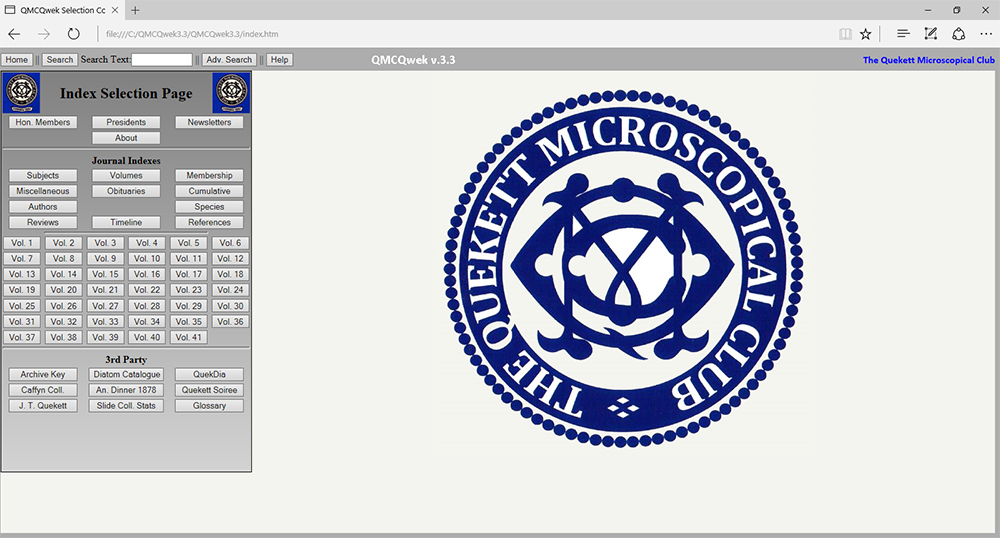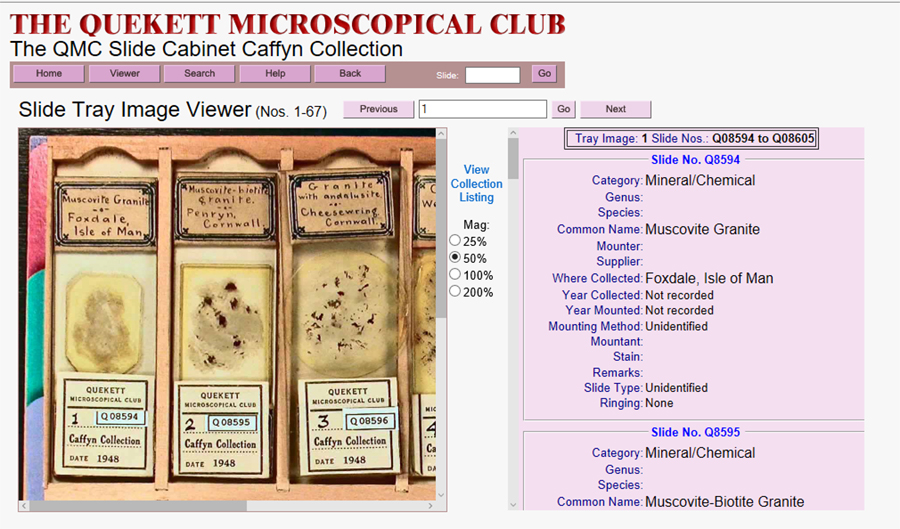
|
by David Walker, UK |
Introduction
In the March 1999 issue of Micscape we reviewed the first digitised archive of the Quekett Microscopical Club Journal from 1868 - 1992 (36 vols.). It was presented on four CD-ROMs, the well established high capacity format of the time. The Club later took advantage of the DVD format, to reissue the original archive on one disc in 2003 and a supplement to update the archive to 2008 (vol. 40). A timeline of the archives issued are illustrated and summarised below.
Readers will be familiar with the current high capacity storage media—the USB flash drive. In Spring 2017 the Club issued a new Journal archive up to 2011 (vol. 41) in this compact and popular format with a variety of additional Club resources included. This article summarises the features offered and the new interface. Readers unfamiliar with the long history of the Quekett Microscopical Club and the resources offered can visit the Club's own splendid website; the original Micscape review also offers a short summary.

Above, three of the four digitised archives offered by the Quekett Microscopical Club to date including the new flash drive. This sequence, in part, reflects the rapid advances in digital storage technology and the willingness of the
Club to adopt them.
Left: The CD-ROM edition issued in 1998 including all journal issues published from 1868 - 1992. A later version of the same archive offered on a single DVD is not shown.
Middle: A DVD edition adding the journal issues published from 1993 - 2008.
Right: The USB flash drive released in 2017 containing the complete archive from 1868 - 2012 and additional features. It has a keyring form and a cap twists to retract the USB connector.
|
Date |
Format |
Contents |
Digitisation |
Interface and design |
Pricing on issue |
|
1998 |
CD-ROM x 4 in presentation box. |
Journal Vols. 1 - 36 |
Cornwall Business Systems |
Web browser. Digital indexes from the Cumulative Index by Michael Newstead, pub. in 1994 by the QMC. |
£85 for club members, |
|
2003 |
DVD-ROM |
Journal Vols. 1 - 36 |
ditto |
ditto |
£120 in Spring 2017 |
|
2009 |
DVD-ROM |
Journal Vols. 37 -40 |
updated archives by |
updated browser interface |
£30 in Spring 2017 |
|
2017 |
USB flash drive |
Journal Vols. 1 - 41 |
updated archives by |
new QMCQwek3.3 interface by |
£10 |
Above. Timeline of digitised archives published to date by the QMC.
In use
The archive can be used either directly from the 8 Gb drive or, as recommended in the Help file, by copying to the hard drive for a likely more responsive use (it occupies ca. 5.2 Gb). The QMCQwek3.3 interface is web browser based and the start.htm file is accessed in the root directory; a link could be added from a user's desktop to either the flash or hard drive using the icon file provided. I used both a desktop (20" screen, 1600 x 900 pixels) and laptop (12" screen, 1280 x 800) running Windows 10 with the flash drive and hard drive copy. It was fast and stable on both using a variety of common browsers* with legibility of resources excellent on both screen sizes. (*Thank you to Steve Gill of Little Imp Publications who notes that early versions of MS Edge did not support all features, the latest version would be recommended if the browser of choice.)
Thank you to Carel Sartory who kindly informs me that the suite also works comfortably on an Android system.
The screenshots below illustrate the attractive, easy to use design and the captions summarise main features. A variety of means of accessing the resources is offered and merits exploration to gain familiarity. If browsing a volume rather than seeking a specific resource, two options are offered that allow quick scanning of a journal part issue. The 'Covers and Advertisements' button accesses the back page of each journal part to review the contents in one image. The 'Page Preview' button also offers a route to quickly scan all pages in a journal part which ideally requires a large screen to judge the content of the smaller page scans.

Full screenshot of the Home page of the QMCQwek3.3 interface using the Microsoft Edge browser. It is attractively laid out with self explanatory buttons to access the journal archives using the criteria offered. A menu bar offers a Home button with both simple and advanced search routines. The latter offers up to three words / phrases to be searched with Boolean AND / OR operators.
The 'Miscellaneous' button accesses a list of 'Microscopical Bibliography', 'Microscopical Preparations' donated to the Club and an 'Archives Key' of the Club's resources carefully compiled by the late and sadly missed Dr. Brian Bracegirdle.
The 'Newsletters' button accesses the 21 issues of this publication to March 1982. The current Bulletin archives are not included.
A new feature offers a number of third party resources associated with the Club which are grouped in the '3rd Party' box.

A typical journal and page display from the recent volume 41. Scans are in 24 bit colour so all colour content is retained. A scroll bar is offered on the right.
Modern high capacity storage formats allow higher resolution scans than the limitations of the original CD format.
Page images up to vol. 36 are typically 506 x 807 pixels, retaining the size of the original archive.
Scans after this exploit the larger capacity formats and are typically 1000 x 1467 pixels. This gives an attractive and very readable display on modern higher resolution screens and large enough for a good quality print out if desired. Inspection of the image file details reveals that a Canon 20D DSLR was used for these more modern scans.
Optimising the tonal balance of white page content to suit a wide audience and viewing formats is somewhat subjective. The tonal balance of page images in the more recent archives after volume 36, has been optimised very well and backgrounds haven't been set to pure white as this can lose edge detail in monochrome content to give a rather fax-like look.
The 'Volumes' button also accesses the first 20 volumes (1868 - 1922) scanned as Acrobat pdfs by the Science Heritage Library.
| Right, detail of menu presented when navigating a recent journal volume. (Menus for the earliest volumes are a little different.) The buttons from left to right are: - 'Page 1 of Volume' - 'Covers and Advertisements' - 'Membership Lists' - 'Author Index' - 'Alphabetical Article Index' - 'Page Preview Index' - 'List of Parts' (for that volume with date of issue & pagination) - 'Original Scanned Pages List' |
|
New '3rd Party' features
The screenshot of the main screen above shows nine buttons under '3rd Party'. These access new features and the archive's own summary of these from the Help page is quoted below.

Above. Screenshot detail of the interface to access the Club's collection of 800 geology slides presented to the Club by Charles Henry Caffyn (1867 - 1954).
A link to the Club's obituary of Caffyn (1867 - 1954) provides background detail.
The Journal offers a particularly rich source of diatom related resources, so the ability to access via genera and species using the QuekDia interface will be of great value to diatomists. The virtual tour of the 800 geology slides in the Caffyn collection presented to the Club in 1948 is also an attractive and valuable resource. This resource alone has clearly had a lot of care and thought put into the interface for ease of use and has its own help page.
Printing
Many users like myself may value printouts of a selected paper or resource. The print routine on browsers tried, prints out the whole screen frame including the menu but the PC user will be familiar with methods to readily print out the page image(s) alone. These include:
1) Right mouse clicking a page scan in Microsoft Internet Explorer 11 (included in Windows 10) offers a print image option. Other browsers tried (MS Edge, Sea Monkey) don't seem to offer direct printing.
2) Once the volume and page number(s) of an item are known, the archive's intuitive directory structure / file naming allows ready access to them using a computer's file navigation menu. Right mouse clicking selected pages brings up the Print routine. The page scans of the original archive to vol. 36 best suited a half A4 page but the higher resolution scans for recent volumes can suit full page A4 if desired.
Pricing
Given the enormous resource offered on the original CDs and later DVDs, the archive represented good value for money. The current two DVDs for 40 volumes cost £150. The pricing of the new USB flash drive is £10 plus postage and packing, i.e. barely above cost. For the information offered and needless to say the phenomenal amount of work required to create the new archive, the flash drive format is excellent value for money.
Conclusion
The latest digitised archive of the Club's Journal has been updated to 2011 (to vol. 41) using a USB flash drive and is well presented with a powerful and versatile updated interface, QMCQwek3.3. The third party features are a valuable addition. The Club and Little Imp Publications (notably Steve Gill) have clearly put a lot of time and effort into the resource and all involved deserve the highest praise. The archive would be appealing to someone who has none of the past issues but is also such good value at
£10, that it would be of interest to owners
of the CD or DVD archives to add the additional volume, new interface and features in a convenient compact format.
The USB flash drive is available in the online shop on the Club's website at www.quekett.org for £10 plus postage and packing.
Update June 19th 2017: Thank you to Ray Trapmore, QMC Sales Officer, who notes that the USB drives are in stock and total cost with postage is: £12.55 UK, £13.55 world zone 1, Australia £13.30. Payment can be made by PayPal email - subscriptions AT quekett DOT org. Contact the Club's Sales Officer if wish to pay by cheque or credit card.
Acknowledgements:
Thank you to Steve Gill of Little Imp Publications for the review copy and for background information.
Screenshots are for review purposes, the interface layout and content are © Little Imp Publications / Quekett Microscopical Club and/or the article authors.
The summary of the third party resources from the Help file is quoted with permission with thanks.
Published in the June 2017 edition of Micscape.
Please report any Web problems or offer general comments to the Micscape Editor .
Micscape is the on-line monthly magazine of the Microscopy UK web site at Microscopy-UK
©
Onview.net Ltd, Microscopy-UK, and all contributors 1995
onwards. All rights reserved.
Main site is at
www.microscopy-uk.org.uk.